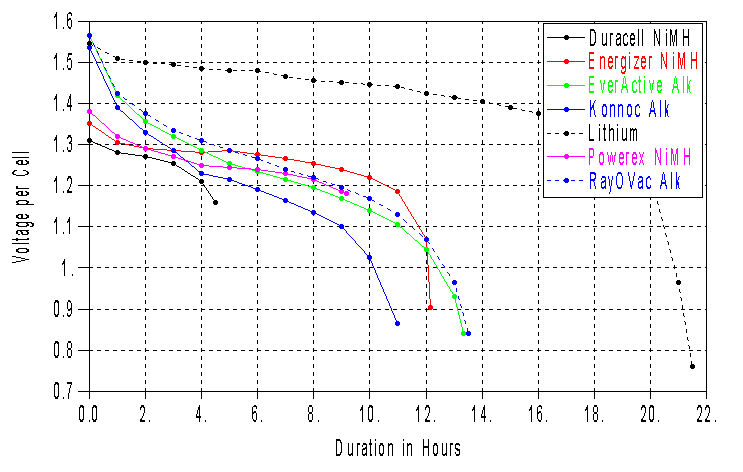
GPS Battery Operational Durations for AA Cells
In an effort to determine the run time of a Magellan Sportrack Color GPS, several different AA batteries were tested on a recording DVM, printing to a thermal printer. The voltmeter system used was a classic, HP-41 programable calculator and HP thermal printer, attached to a Corvallis Micro Technology, Inc. CMT-300 Programable Measurement System to measure battery voltage while the GPS was continually on with the backlighting off. The tests were done at room temperature and may not be relevant at freezing to subzero temperatures.
The AA alkaline and Lithium batteries were fresh from Walmart and the NiMH batteries were freshly charged in a quality charger. The prices listed are approximate, depending on where you can buy them. This tests were done as the result of questioning some NiMH (commercial Duracell batteries obtained at a flea market several years ago) lasting only 4 hours, while the advertised duration was supposed to be 14 hours with alkaline batteries. The following table shows that the Lithium AA cells give the longest time with over 21 hours power, but at a severe cost of about $4.75 per run. (The Magellan GPS requires two AA batteries for power.) The alkaline batteries, at about $1 per run, last about the same as the Magellan 14 hour advertised life, except for the Konnoc (China) batteries ($0.50/run) obtained in a local Job Lot store. There was no appreciable difference between the RayOVac and the Walmart 'EverActive' house brand. The NiMH rechargeables were the obvious choice for long term use. The 2000 mAh lasted around 9 hours and the 2300 mAh lasted 12 hours, the latter about the same as the alkaline batteries.

The following table is the recorded data used presented in the graph above. The orange highlighted data below is when the GPS unit shut itself off as indicated by a rise of voltage on the DVM. The unit emits a low level alarm before this voltage, but gives you very little reserve time, from none to several minutes.
|
Time (hrs:min) |
00:00 |
01:00 |
02:00 |
03:00 |
04:00 |
04:30 |
05:00 |
06:00 |
07:00 |
08:00 |
09:00 |
09:05 |
10:00 |
11:00 |
12:00 |
12:10 |
13:00 |
13:20 |
13:30 |
14:00 |
15:00 |
16:00 |
17:00 |
18:00 |
19:00 |
20:00 |
21:00 |
21:20 |
|
Duracell NiMH (flea market $1/cell) |
1.310 |
1.280 |
1.270 |
1.255 |
1.210 |
1.160 |
|
|
|
|
|
|
|
|
|
|
|
|
|
|
|
|
|
|
|
|
|
|
|
Maha Powerex NiMH 2000 mAh ($2.25/cell) |
1.380 |
1.320 |
1.290 |
1.270 |
1.250 |
|
1.245 |
1.240 |
1.230 |
1.215 |
1.185 |
1.180 |
|
|
|
|
|
|
|
|
|
|
|
|
|
|
|
|
|
Konnoc Alk (Ocean State Job Lot) ($0.26/cell) |
1.535 |
1.390 |
1.330 |
1.285 |
1.230 |
|
1.215 |
1.190 |
1.165 |
1.135 |
1.100 |
|
1.025 |
0.865 |
|
|
|
|
|
|
|
|
|
|
|
|
|
|
|
Energizer NiMH 2300 mAh ($2.34/cell) |
1.350 |
1.305 |
1.290 |
1.285 |
1.280 |
|
1.285 |
1.275 |
1.265 |
1.255 |
1.240 |
|
1.220 |
1.185 |
1.070 |
0.905 |
|
|
|
|
|
|
|
|
|
|
|
|
|
EverActive Alk (Walmart) ($0.51/cell) |
1.565 |
1.420 |
1.355 |
1.320 |
1.285 |
|
1.255 |
1.235 |
1.215 |
1.195 |
1.170 |
|
1.140 |
1.105 |
1.045 |
|
0.930 |
0.840 |
|
|
|
|
|
|
|
|
|
|
|
RayOVac Alk ($0.64/cell) |
1.565 |
1.425 |
1.375 |
1.335 |
1.310 |
|
1.285 |
1.265 |
1.240 |
1.220 |
1.195 |
|
1.170 |
1.130 |
1.070 |
|
0.965 |
|
0.840 |
|
|
|
|
|
|
|
|
|
|
Energizer Lithium ($2.34/cell) |
1.545 |
1.510 |
1.500 |
1.495 |
1.485 |
|
1.480 |
1.480 |
1.465 |
1.455 |
1.450 |
|
1.445 |
1.440 |
1.425 |
|
1.415 |
|
|
1.405 |
1.390 |
1.375 |
1.370 |
1.340 |
1.305 |
1.225 |
0.965 |
0.760 |
Individual current reads were taken with new and almost depleted batteries. The nature of the GPS circuit does not appear to draw constant current, resulting in a fluctuating reading. The following are eyeball average readings. Current measurements were not able to be recorded in parallel with the voltage runs because of the DVM voltage burden in current mode just about doubled the drain on the batteries, which would have biased the run times.
|
Voltage (approx) |
1.5 vdc |
1.1 vdc |
|---|---|---|
|
No backlighting |
130 ma |
160 ma |
|
½ backlighting |
180 ma |
200 ma |
|
Full backlighting |
220 ma |
240 ma |
While these tests were run on a Magellan Sportrack Color GPS, I assume that the relative differences in run time would apply to any other handheld GPS brand.
Click here for a PDF download of this document.
This page constructed by Michael Krabach, www.krabach.info , using the OpenOffice 1.1 open source office suite (www.openoffice.org), ES-Plot by BFMT Software (www.mae.usu.edu/faculty/stevef/prg/Freeware.html) , and Hypersnap-DX screen capture (www.hyperionics.com ). Rev 8-20-2004